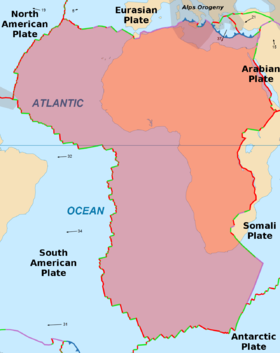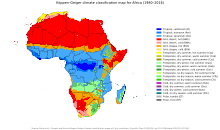The  African Plate is a major tectonic plate straddling the equator as well as the prime meridian. It includes much of the continent of Africa, as well as oceanic crust which lies between the continent and various surrounding ocean ridges. Between 60 million years ago and 10 million years ago, the Somali Plate began rifting from the African Plate along the East African Rift.
African Plate is a major tectonic plate straddling the equator as well as the prime meridian. It includes much of the continent of Africa, as well as oceanic crust which lies between the continent and various surrounding ocean ridges. Between 60 million years ago and 10 million years ago, the Somali Plate began rifting from the African Plate along the East African Rift.
Since the continent of Africa consists of crust from both the African and the Somali plates, some literature refers to the African Plate as the Nubian Plate to distinguish it from the continent as a whole.[110]
Geologically, Africa includes the Arabian Peninsula; the Zagros Mountains of Iran and the Anatolian Plateau of Turkey mark where the African Plate collided with Eurasia. The Afrotropical realm and the Saharo-Arabian desert to its north unite the region biogeographically, and the Afro-Asiatic language family unites the north linguistically.

Africa map of Köppen climate classification
The climate of Africa ranges from tropical to subarctic on its highest peaks. Its northern half is primarily desert, or arid, while its central and southern areas contain both savanna plains and dense jungle (rainforest) regions. In between, there is a convergence, where vegetation patterns such as sahel and steppe dominate. Africa is the hottest continent on Earth and 60% of the entire land surface consists of drylands and deserts.[112] The record for the highest-ever recorded temperature, in Libya in 1922 (58 °C (136 °F)), was discredited in 2013.
Fauna
Savanna at Ngorongoro Conservation Area, Tanzania
Africa boasts perhaps the world’s largest combination of density and “range of freedom” of wild animal populations and diversity, with wild populations of large carnivores (such as lions, hyenas, and cheetahs) and herbivores (such as buffalo, elephants, camels, and giraffes) ranging freely on primarily open non-private plains. It is also home to a variety of “jungle” animals including snakes and primates and aquatic life such as crocodiles and amphibians. In addition, Africa has the largest number of megafauna species, as it was least affected by the extinction of the Pleistocene megafauna.
Ecology and biodiversity

Tropical beach in Trou-aux-Biches, Mauritius
Africa has over 3,000 protected areas, with 198 marine protected areas, 50 biosphere reserves, and 80 wetlands reserves. Significant habitat destruction, increases in human population and poaching are reducing Africa’s biological diversity and arable land. Human encroachment, civil unrest and the introduction of non-native species threaten biodiversity in Africa. This has been exacerbated by administrative problems, inadequate personnel and funding problems.
Deforestation is affecting Africa at twice the world rate, according to the United Nations Environment Programme (UNEP). According to the University of Pennsylvania African Studies Center, 31% of Africa’s pasture lands and 19% of its forests and woodlands are classified as degraded, and Africa is losing over four million hectares of forest per year, which is twice the average deforestation rate for the rest of the world. Some sources claim that approximately 90% of the original, virgin forests in West Africa have been destroyed.[116] Over 90% of Madagascar‘s original forests have been destroyed since the arrival of humans 2000 years ago.[117] About 65% of Africa’s agricultural land suffers from soil degradation.[118]
See also: Afrotropical realm and Palearctic realm
Environmental issues
This section is an excerpt from Environmental issues in Africa[edit]
African environmental issues are caused by anthropogenic effects on the African natural environment and have major impacts on humans and nearly all forms of endemic life. Issues include desertification, problems with access to safe water supply, population explosion and fauna depletion. These issues are ultimately linked to over-population in Africa, as well as on a global scale. Nearly all of Africa’s environmental problems are geographically variable and human induced, though not necessarily by Africans.[119]


